1. Introduction
In the previous example we accepted all defaults and inspected the filter chain and API responses to gain an understanding of the Spring Security framework. In this chapter we will begin customizing the authentication configuration to begin to show how and why this can be accomplished.
1.1. Goals
You will learn:
-
to create a customized security authentication configurations
-
to obtain the identity of the current, authenticated user for a request
-
to incorporate authentication into unit integration tests
1.2. Objectives
At the conclusion of this lecture and related exercises, you will be able to:
-
create multiple, custom authentication filter chains
-
enable open access to static resources
-
enable anonymous access to certain URIs
-
enforce authenticated access to certain URIs
-
locate the current authenticated user identity
-
enable Cross-Origin Resource Sharing (CORS) exchanges with browsers
-
add an authenticated identity to RestTemplate and RestClient clients
-
add authentication to integration tests
2. Configuring Security
To override security defaults and define a customized FilterChainProxy-- we
must supply one or more classes that define our own SecurityFilterChain(s).
2.1. WebSecurityConfigurer and Component-based Approaches
Spring has provided two ways to do this:
-
WebSecurityConfigurer/ WebSecurityConfigurerAdapter - is the legacy, deprecated (Spring Security 5.7.0-M2; 2022), and later removed (Spring 6) definition class that acts as a modular factory for security aspects of the application. [1] There can be one-to-NWebSecurityConfigurersand each can define aSecurityFilterChainand supporting services. -
Component-based configuration - is the modern approach to defining security aspects of the application. The same types of components are defined with the component-based approach, but they are instantiated in independent
@Beanfactories. Any interdependency between the components is wired up using beans injected into the@Beanfactory.
Early versions of Spring were based solely on the WebSecurityConfigurer method.
Later versions of Spring 5 provided support for both.
Spring 6 now only supports the Component-based method.
Since you will likely encounter the WebSecurityConfigurer approach for a long while in older applications, I will provide some coverage of that here.
However, the main focus will be the Spring 6 Component-based approach.
Refer to older versions of the course examples and notes for more focused coverage of the WebSecurityConfigurer approach.
To highlight that the FilterChainProxy is populated with a prioritized list of SecurityFilterChain — I am going to purposely create multiple chains.
-
one with the API rules (
APIConfiguration) - highest priority -
one with the former default rules (
AltConfiguration) - lowest priority -
one with access rules for Swagger (
SwaggerSecurity) - medium priority
The priority indicates the order in which they will be processed and will also influence the order for the SecurityFilterChain s they produce.
Normally I would not highlight Swagger in these examples — but it provides an additional example of how we can customize Spring Security.
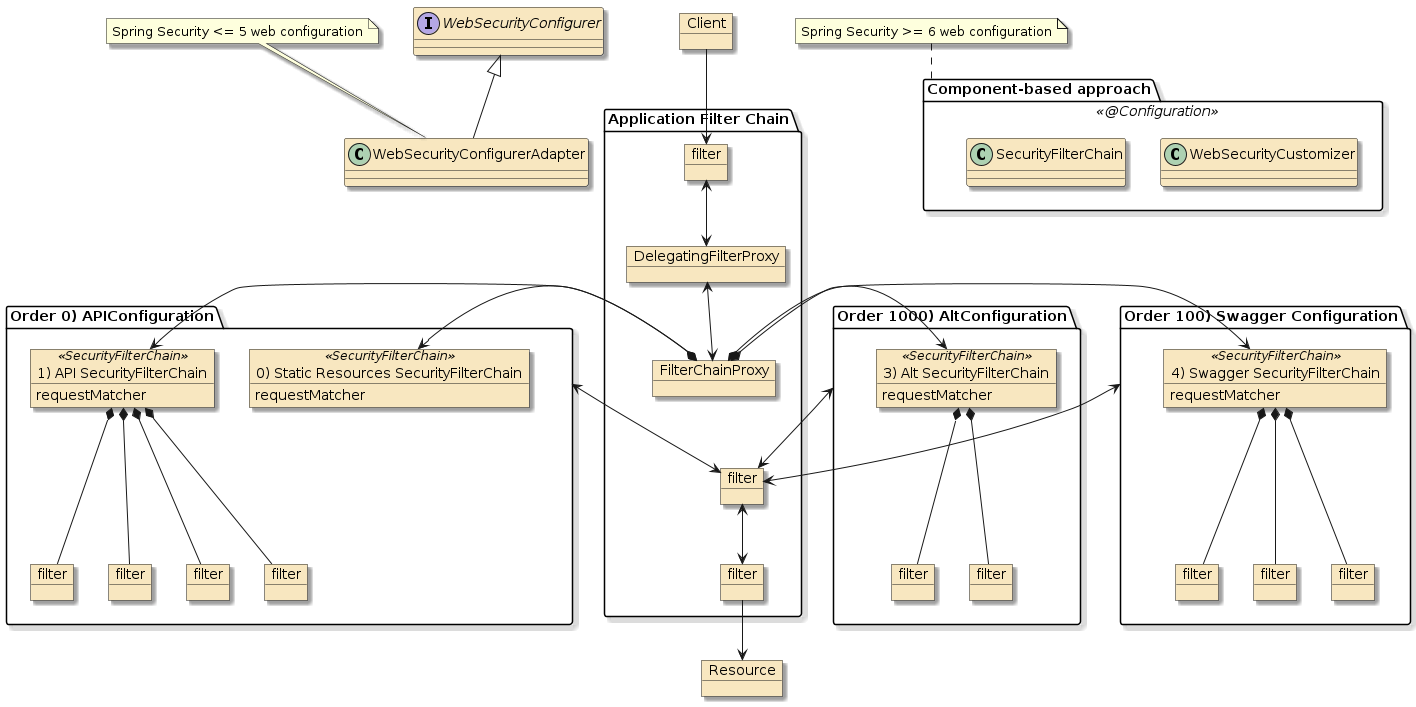
2.2. Core Application Security Configuration
The example will eventually contain several SecurityFilterChains, but let’s start with focusing on just one of them — the "API Configuration".
This initial configuration will define the configuration for access to static resources, dynamic resources, and how to authenticate our users.
2.2.1. WebSecurityConfigurerAdapter Approach
In the legacy WebSecurityConfiguration approach, we would start by defining a @Configuration class that extends WebSecurityConfigurerAdapter and overrides one or more of its configuration methods.
|
Legacy WebSecurityConfigurer no Longer Exists
Reminder - the legacy WebSecurityConfigurer approach does not exist in Spring Boot 3 / Spring Security 6.
It is included here as an aid for those that may be transitioning from a legacy baseline.
|
@Configuration(proxyBeanMethods = false)
@Order(0) (2)
public class APIConfiguration extends WebSecurityConfigurerAdapter { (1)
@Override
public void configure(WebSecurity web) throws Exception { ... } (3)
@Override
protected void configure(HttpSecurity http) throws Exception { ... } (4)
@Override
protected void configure(AuthenticationManagerBuilder auth) throws Exception { ... } (5)
@Bean
@Override
public AuthenticationManager authenticationManagerBean() throws Exception { ... } (6)| 1 | Create @Configuration class that extends WebSecurityConfigurerAdapter to customize SecurityFilterChain |
| 2 | APIConfiguration has a high priority resulting SecurityFilterChain for dynamic resources |
| 3 | configure a SecurityFilterChain for static web resources |
| 4 | configure a SecurityFilterChain for dynamic web resources |
| 5 | optionally configure an AuthenticationManager for multiple authentication sources |
| 6 | optionally expose AuthenticationManager as an injectable bean for re-use in other SecurityFilterChains |
Each SecurityFilterChain would have a reference to its AuthenticationManager.
The WebSecurityConfigurerAdapter provided the chance to custom configure the AuthenticationManager using a builder.
The adapter also provided an accessor method that exposed the built AuthenticationManager as a pre-built component for other SecurityFilterChains to reference.
2.2.2. Component-based Approach
In the modern Component-based approach, we define each aspect of our security infrastructure as a separate component.
These @Bean factory methods are within a normal @Configuration class that requires no inheritance.
The names of the @Bean factory methods have no significance as long as they are unique.
Only what they return has significance.
import org.springframework.security.config.annotation.web.builders.HttpSecurity;
import org.springframework.security.config.annotation.web.configuration.WebSecurityCustomizer;
import org.springframework.security.web.SecurityFilterChain;
...
@Bean
public WebSecurityCustomizer apiStaticResources() { ... } (1)
@Bean
@Order(Ordered.HIGHEST_PRECEDENCE) //0 (3)
public SecurityFilterChain apiSecurityFilterChain(HttpSecurity http) throws Exception { ...} (2)
@Bean
public AuthenticationManager authnManager(HttpSecurity http, ...) throws Exception { (5)
AuthenticationManagerBuilder builder = http (4)
.getSharedObject(AuthenticationManagerBuilder.class);
... }| 1 | define a bean to configure a SecurityFilterChain for static web resources |
| 2 | define a bean to configure a SecurityFilterChain for dynamic web resources |
| 3 | high priority assigned to SecurityFilterChain |
| 4 | optionally configure an AuthenticationManager for multiple authentication sources |
| 5 | expose AuthenticationManager as an injectable bean for use in SecurityFilterChains |
The SecurityFilterChain for static resources gets defined within a lambda function implementing the WebSecurityCustomizer interface.
The SecurityFilterChain for dynamic resources gets directly defined by within the @Bean factory method.
There is no longer any direct linkage between the configuration of the AuthenticationManager and the SecurityFilterChains being built.
The linkage is provided through a getSharedObject call of the HttpSecurity object that can be injected into the bean methods.
2.3. Ignoring Static Resources
One of the easiest rules to put into place is to provide open access to static content. This is normally image files, web CSS files, etc. Spring recommends not including dynamic content in this list. Keep it limited to static files.
Access is defined by configuring the WebSecurity object.
-
In the legacy
WebSecurityConfigurerAdapterapproach, the modification was performed within the method overriding theconfigure(WebSecurity)method. Note that Spring 5WebSecurityinterface contained builder methods forRequestMatcher(e.g.,antMatchers()) that no longer exist.Ignore Static Content Configuration - Legacy WebSecurityConfigurerAdapter approachimport org.springframework.security.config.annotation.web.builders.WebSecurity; @Configuration @Order(0) public class APIConfiguration extends WebSecurityConfigurerAdapter { @Override public void configure(WebSecurity web) throws Exception { web.ignoring().antMatchers("/content/**"); } -
In the modern Component-based approach, a lambda function implementing the
WebSecurityCustomizerfunctional interface is returned. That lambda will be called to customize theWebSecurityobject. Spring 6 made a breaking change to theWebSecurityinterface by removing the approach-specific builders for matchers (e.g.,antMatchers()) and generalized the call torequestMatchers(). Under the hood, by default, Spring will create a matcher that best suites the runtime environment — which will beMvcRequestMatcherin Spring MVC environments.Ignore Static Content Configuration - Modern Component-based approachimport org.springframework.security.config.annotation.web.configuration.WebSecurityCustomizer; @Bean public WebSecurityCustomizer apiStaticResources() { return (web)->web.ignoring().requestMatchers("/content/**"); (1) }1 delegating to Spring to create the correct matcher WebSecurityCustomers Functional Interfacepublic interface WebSecurityCustomizer { void customize(WebSecurity web); }
MvcRequestMatcher is used by Spring MVC to implement URI matching based on the actual URIs hosted within Spring MVC.
The expression is still an Ant expression.
It is just performed using more knowledge of the hosted resources within Spring MVC.
The MvcRequestMatcher implementation is said to be less prone to definition error when using Spring MVC.
Spring will revert to AntRequestMatcher when running in alternate Servlet environments (e.g., JAX-RS).
|
The generic requestMatchers() approach did not work when the application contained a blend of Spring MVC and non-Spring MVC (e.g., H2 Database UI) servlets.
In those cases, we had to use an explicit approach documented in CVE-2023-34035.
This has since been fixed.
|
Remember — our static content is packaged within the application by placing it
under the src/main/resources/static directory of the source tree.
$ tree src/main/resources/
src/main/resources/
|-- application.properties
`-- static
`-- content
|-- hello.js
|-- hello_static.txt
`-- index.html
$ cat src/main/resources/static/content/hello_static.txt
Hello, static fileWith that rule in place, we can now access our static file without any credentials.
$ curl -v -X GET http://localhost:8080/content/hello_static.txt
> GET /content/hello_static.txt HTTP/1.1
>
< HTTP/1.1 200
< Vary: Origin
< Vary: Access-Control-Request-Method
< Vary: Access-Control-Request-Headers
< Last-Modified: Fri, 03 Jul 2020 19:36:25 GMT
< Cache-Control: no-store
< Accept-Ranges: bytes
< Content-Type: text/plain
< Content-Length: 19
< Date: Fri, 03 Jul 2020 20:55:58 GMT
<
Hello, static file2.4. SecurityFilterChain Matcher
The meat of the SecurityFilterChain definition is within the configuration of the HttpSecurity object.
The resulting SecurityFilterChain will have a RequestMatcher that identifies which URIs the identified rules apply to.
The default is to match "any" URI.
In the example below I am limiting the configuration to URIs at and below /api/anonymous and /api/authn.
The matchers also allow a specific HTTP method to be declared in the definition.
-
In the legacy
WebSecurityConfigurerAdapterapproach, configuration is performed in the method overriding theconfigure(HttpSecurity)method. The legacyHttpSecurityinterface provided builders that directly supported building different types of matchers (e.g.,antMatchers()).SecurityFilterChain Matcher - WebSecurityConfigurerAdapter approachimport org.springframework.security.config.annotation.web.builders.HttpSecurity; @Configuration @Order(0) public class APIConfiguration extends WebSecurityConfigurerAdapter { @Override protected void configure(HttpSecurity http) throws Exception { http.requestMatchers(m->m.antMatchers("/api/anonymous/**","/api/authn/**"));(1) //... (2) } ...1 rules within this configuration will apply to URIs below /api/anonymousand/api/authn2 http.build()is not called
This method returns void and the build() method of HttpSecurity should not be called.
|
-
In the modern Component-based approach, the configuration is performed in a
@Beanmethod that will directly return theSecurityFilterChain. It has the sameHttpSecurityobject injected, but note thatbuild()is called within this method to return aSecurityFilterChain. Spring 6 made breaking changes to:-
the
HttpSecurityinterface by changingrequestMatchers()tosecurityMatchers()in order to better distinguish between the pattern matching (requestMatchers) versus the role of the pattern matching (securityMatchers). ThesecurityMatchers()method defines the aggregateRequestMatchersthat are used to identify which calls invoke thisSecurityFilterChain -
the
AbstractRequestMatcherRegistryinterface by removing type-specific matcher builders (e.g., removedantMatchers()) and generalized torequestMatchers()
Component-based HttpSecurity Configuration@Bean @Order(0) public SecurityFilterChain filterChain(HttpSecurity http) throws Exception { http.securityMatchers(m->m.requestMatchers("/api/anonymous/**","/api/authn/**"));(1) //... return http.build(); (2) }1 rules within this configuration will apply to URIs below /api/anonymousand/api/authn2 http.build()is required for this@Beanfactory -
This method returns the SecurityFilterChain result of calling the build() method of HttpSecurity.
This is different from the deprecated approach.
|
2.5. SecurityFilterChain with Explicit MvcRequestMatcher
The following lists the same solution using an explicit MvcRequestMatcher.
The MvcRequestMatcher must be injected as a component because it requires knowledge of the servlet environment.
import org.springframework.web.servlet.handler.HandlerMappingIntrospector;
@Bean
MvcRequestMatcher.Builder mvc(HandlerMappingIntrospector introspector) {
return new MvcRequestMatcher.Builder(introspector);
}
@Bean
@Order(Ordered.HIGHEST_PRECEDENCE) //0
public SecurityFilterChain apiSecurityFilterChain(HttpSecurity http,
MvcRequestMatcher.Builder mvc) throws Exception {
http.securityMatchers(m->m.requestMatchers(
mvc.pattern("/api/anonymous/**"),
mvc.pattern("/api/authn/**")
));2.6. HttpSecurity Builder Methods
The HttpSecurity object is "builder-based" and has several options on how it
can be called.
-
http.methodAcceptingBuilt(builtObject) -
http.methodReturningBuilder().customizeBuilder()(non-lambda) -
http.methodPassingBuilderToLambda(builder→builder.customizeBuilder())
2.6.1. Deprecated non-Lambda Methods
Spring Security 6 has deprecated the non-lambda customize approach (for removal in Spring Security 7) in favor of the lambda approach. [2] The following non-lambda approach (supplying no options) will result in a deprecation warning.
http.httpBasic();Spring Security has added a Customizer.withDefaults() construct that can mitigate the issue when supplying no customizations.
import org.springframework.security.config.Customizer;
http.httpBasic(Customizer.withDefaults());2.6.2. Chaining not Necessary
The builders are also designed to be chained. It is quite common to see the following syntax used.
http.authorizeRequests(cfg->cfg.anyRequest().authenticated())
.formLogin(Customizer.withDefaults())
.httpBasic(Customizer.withDefaults());As much as I like chained builders — I am not a fan of that specific syntax when starting out. Especially if we are experimenting and commenting/uncommenting configuration statements. We can simply make separate calls. You will see me using separate calls. Either style functionally works the same.
http.authorizeRequests(cfg->cfg.anyRequest().authenticated());
http.formLogin(Customizer.withDefaults());
http.httpBasic(Customizer.withDefaults());2.7. Match Requests
We first want to scope our HttpSecurity configuration commands using one of the securityMatcher methods.
We can provide a RequestMatcher using securityMatcher() or a configurer using securityMatchers().
The following will create a RequestMatcher that will match any HTTP method and URI below /api/anonymous and /api/authn.
We can add an Http.(METHOD) if we want it to be specific to only that HTTP method.
http.securityMatchers(m->m.requestMatchers("/api/anonymous/**","/api/authn/**")); (1)
//http.securityMatcher("/api/anonymous/**","/api/authn/**"); (2)| 1 | matches all HTTP methods matching the given URI patterns |
| 2 | shortcut when no HttpMethod is needed |
|
RequestMatchers can be Aggregated
The code above technically creates three (3) RequestMatchers.
Two (2) to match the individual (method)/URIs and one (1) parent to aggregate them into an "or" predicate.
|
The requestMatchers() configurer (*in non-ambiguous environments) will create an MvcRequestMatcher under the hood when Spring MVC is present and an AntRequestMatcher for other servlet frameworks.
The MvcRequestMatcher is said to be less prone to error (i.e., missed matches) than other techniques.
Spring 6 took away builder methods to directly create the AntRequestMatcher (and other explicit types), but they can still be created manually.
This technique can be used to create any type of RequestMatcher.
import org.springframework.security.web.util.matcher.OrRequestMatcher;
import org.springframework.security.web.util.matcher.RegexRequestMatcher;
http.securityMatcher(new OrRequestMatcher((2)
RegexRequestMatcher.regexMatcher("^/api/anonymous$"),(1)
RegexRequestMatcher.regexMatcher("^/api/anonymous/.*"),
RegexRequestMatcher.regexMatcher("^/api/authn$"),
RegexRequestMatcher.regexMatcher("^/api/authn/.*")
));| 1 | supplying an explicit type of RequestMatcher |
| 2 | Spring Security is aggregating the list into an OrRequestMatcher |
Notice the requestMatcher is the primary property in the individual chains and the rest of the configuration is impacting the filters within that chain.
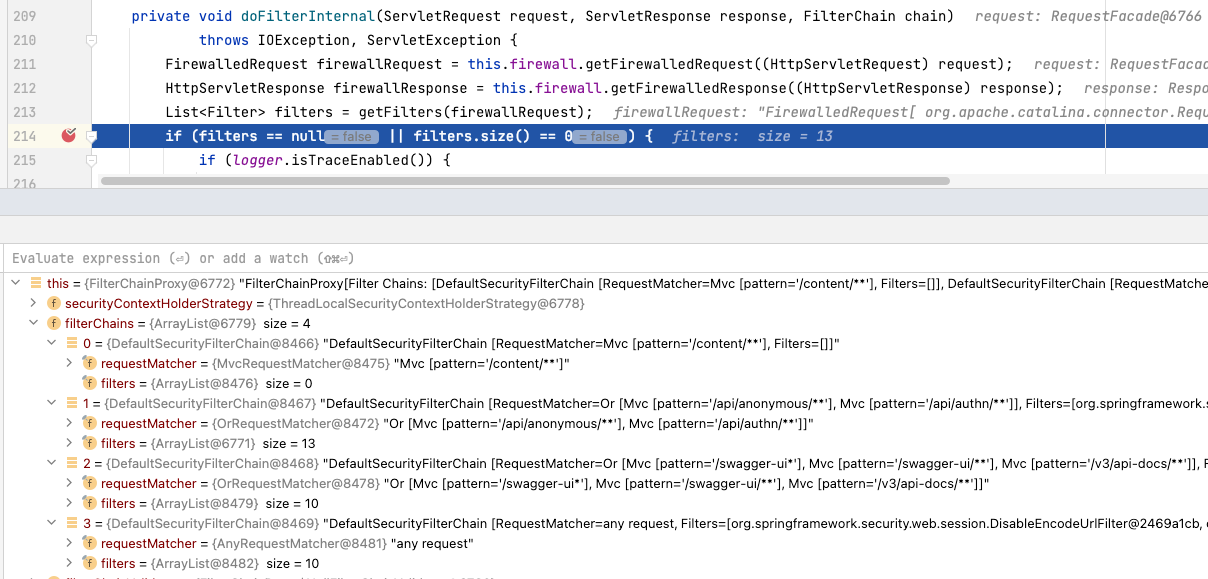
Notice also that our initial SecurityFilterChain is within the other chains in the example and is high in priority because of our @Order value assignment:
|
2.8. Authorize Requests
Next I am showing the authentication requirements of the SecurityFilterChain.
Calls to the /api/anonymous URIs do not require authentication.
Calls to the /api/authn URIs do require authentication.
http.authorizeHttpRequests(cfg->cfg.requestMatchers("/api/anonymous/**").permitAll());
http.authorizeHttpRequests(cfg->cfg.anyRequest().authenticated());The permissions off the matcher include:
-
permitAll() - no constraints
-
denyAll() - nothing will be allowed
-
authenticated() - only authenticated callers may invoke these URIs
-
role restrictions that we won’t be covering just yet
You can also make your matcher criteria method-specific by adding in a HttpMethod specification.
import org.springframework.http.HttpMethod;
...
...(cfg->cfg.requestMatchers(HttpMethod.GET,"/api/anonymous/**").permitAll())
...(cfg->cfg.requestMatchers(HttpMethod.GET).permitAll())|
requestMatchers are evaluated after satisfying securityMatcher(s)
RequestMatchers are evaluated within the context of what satisfied the filter’s securityMatcher(s).
If you form a Security FilterChain for a specific base URI, the requestMatcher is only defining rules for what that chain processes.
|
2.9. Authentication
In this part of the example, I am enabling BASIC Auth and eliminating FORM-based authentication. For demonstration only — I am providing a custom name for the realm name returned to browsers.
http.httpBasic(cfg->cfg.realmName("AuthConfigExample")); (1)
http.formLogin(cfg->cfg.disable());| Realm name is not a requirement to activate Basic Authentication. It is shown here solely as an example of something easily configured. |
< HTTP/1.1 401 < WWW-Authenticate: Basic realm="AuthConfigExample" (1)
| 1 | Realm Name returned in HTTP responses requiring authentication |
2.10. Header Configuration
In this portion of the example, I am turning off two of the headers that were part of the default set: XSS protection and frame options. There seemed to be some debate on the value of the XSS header [3] and we have no concern about frame restrictions. By disabling them — I am providing an example of what can be changed.
CSRF protections have also been disabled to make non-safe methods more sane to execute at this time.
Otherwise, we would be required to supply a value in a POST that came from a previous GET (all maintained and enforced by optional filters).
http.headers(cfg->{
cfg.xssProtection(xss-> xss.disable());
cfg.frameOptions(fo->fo.disable());
});
http.csrf(cfg->cfg.disable());2.11. Stateless Session Configuration
I have no interest in using the Http Session to maintain identity
between calls — so this should eliminate the SET-COOKIE commands
for the JSESSIONID.
http.sessionManagement(cfg->
cfg.sessionCreationPolicy(SessionCreationPolicy.STATELESS));3. Configuration Results
With the above configurations in place — we can demonstrate the desired functionality and trace the calls through the filter chain if there is an issue.
3.1. Successful Anonymous Call
The following shows a successful anonymous call and the returned headers.
Remember that we have gotten rid of several unwanted features with their headers.
The controller method has been modified to return the identity of the authenticated caller. We will take a look at that later — but know the source of the additional :caller= string was added for this wave of examples.
$ curl -v -X GET http://localhost:8080/api/anonymous/hello?name=jim
> GET /api/anonymous/hello?name=jim HTTP/1.1
< HTTP/1.1 200
< X-Content-Type-Options: nosniff
< Cache-Control: no-cache, no-store, max-age=0, must-revalidate
< Pragma: no-cache
< Expires: 0
< Content-Type: text/plain;charset=UTF-8
< Content-Length: 25
< Date: Fri, 03 Jul 2020 22:11:11 GMT
<
hello, jim :caller=(null) (1)| 1 | we have no authenticated user |
3.2. Successful Authenticated Call
The following shows a successful authenticated call and the returned headers.
$ curl -v -X GET http://localhost:8080/api/authn/hello?name=jim -u user:password (1)
> GET /api/authn/hello?name=jim HTTP/1.1
> Authorization: BASIC dXNlcjpwYXNzd29yZA==
< HTTP/1.1 200
< X-Content-Type-Options: nosniff
< Cache-Control: no-cache, no-store, max-age=0, must-revalidate
< Pragma: no-cache
< Expires: 0
< Content-Type: text/plain;charset=UTF-8
< Content-Length: 23
< Date: Fri, 03 Jul 2020 22:12:34 GMT
<
hello, jim :caller=user (2)| 1 | example application configured with username/password of user/password |
| 2 | we have an authenticated user |
3.3. Rejected Unauthenticated Call Attempt
The following shows a rejection of an anonymous caller attempting to invoke a URI requiring an authenticated user.
$ curl -v -X GET http://localhost:8080/api/authn/hello?name=jim (1)
> GET /api/authn/hello?name=jim HTTP/1.1
< HTTP/1.1 401
< WWW-Authenticate: Basic realm="AuthConfigExample"
< X-Content-Type-Options: nosniff
< Cache-Control: no-cache, no-store, max-age=0, must-revalidate
< Pragma: no-cache
< Expires: 0
< Content-Type: application/json
< Transfer-Encoding: chunked
< Date: Fri, 03 Jul 2020 22:14:20 GMT
<
{"timestamp":"2020-07-03T22:14:20.816+00:00","status":401,
"error":"Unauthorized","message":"Unauthorized","path":"/api/authn/hello"}| 1 | attempt to make anonymous call to authentication-required URI |
4. Authenticated User
Authenticating the identity of the caller is a big win. We likely will want their identity at some point during the call.
4.1. Inject UserDetails into Call
One option is to inject the UserDetails containing the username (and authorities) for the
caller. Methods that can be called without authentication will receive the UserDetails
if the caller provides credentials but must protect itself against a null value if actually
called anonymously.
import org.springframework.security.core.annotation.AuthenticationPrincipal;
import org.springframework.security.core.userdetails.UserDetails;
...
public String getHello(@RequestParam(name = "name", defaultValue = "you") String name,
@AuthenticationPrincipal UserDetails user) {
return "hello, " + name + " :caller=" + (user==null ? "(null)" : user.getUsername());
}4.2. Obtain SecurityContext from Holder
The other option is to look up the UserDetails through the SecurityContext stored within the SecurityContextHolder class. This allows any caller in the call flow to obtain the identity of the caller at any time.
import org.springframework.security.core.context.SecurityContextHolder;
public String getHelloAlt(@RequestParam(name = "name", defaultValue = "you") String name) {
Authentication authentication = SecurityContextHolder
.getContext()
.getAuthentication();
Object principal = null!=authentication ? authentication.getPrincipal() : "(null)";
String username = principal instanceof UserDetails ?
((UserDetails)principal).getUsername() : principal.toString();
return "hello, " + name + " :caller=" + username;
}5. Swagger BASIC Auth Configuration
Once we enabled default security on our application — we lost the ability to fully utilize the Swagger page.
We did not have to create a separate SecurityFilterChain for just the Swagger endpoints — but doing so provides some nice modularity and excuse to further demonstrate Spring Security configurability.
|
Check Defaults
Spring Boot used to always apply a default filter with authenticated(), denying access to any URI lacking a matching securityMatcher.
Spring Boot 3.3.2 no longer applies a default filter when one is provided (as we did above) — leaving it unevaluated, resulting in open access and other defaults.
Swagger UI can be accessed in this setting, but the BASIC authentication within the page is inoperable.
Verify default behavior in addition to the URIs of importance to your application.
|
I have added a separate security configuration for the OpenAPI and Swagger endpoints.
5.1. Swagger Authentication Configuration
The following configuration allows the OpenAPI and Swagger endpoints to be accessed anonymously and handle authentication within OpenAPI/Swagger.
-
Swagger SecurityFilterChain using the legacy
WebSecurityConfigurerAdapterapproach@Configuration(proxyBeanMethods = false) @Order(100) (1) public class SwaggerSecurity extends WebSecurityConfigurerAdapter { @Override protected void configure(HttpSecurity http) throws Exception { http.requestMatchers(cfg->cfg .antMatchers("/swagger-ui*", "/swagger-ui/**", "/v3/api-docs/**")); http.authorizeRequests(cfg->cfg.anyRequest().permitAll()); http.csrf().disable(); } }1 Priority (100) is after core application (0) and prior to default rules (1000) -
Swagger SecurityFilterChain using the modern Component-based approach
@Bean @Order(100) (1) public SecurityFilterChain swaggerSecurityFilterChain(HttpSecurity http) throws Exception { http.securityMatchers(cfg->cfg .requestMatchers("/swagger-ui*", "/swagger-ui/**", "/v3/api-docs/**")); http.authorizeHttpRequests(cfg->cfg.anyRequest().permitAll()); http.csrf(cfg->cfg.disable()); return http.build(); }1 Priority (100) is after core application (0) and prior to default rules (1000)
5.2. Swagger Security Scheme
In order for Swagger to supply a username:password using BASIC Auth, we need
to define a SecurityScheme for Swagger to use. The following
bean defines the core object the methods will be referencing.
package info.ejava.examples.svc.authn;
import io.swagger.v3.oas.models.Components;
import io.swagger.v3.oas.models.OpenAPI;
import io.swagger.v3.oas.models.security.SecurityScheme;
import org.springframework.context.annotation.Bean;
...
@Bean
public OpenAPI customOpenAPI() {
return new OpenAPI()
.components(new Components()
.addSecuritySchemes("basicAuth",
new SecurityScheme()
.type(SecurityScheme.Type.HTTP)
.scheme("basic")));
}The @Operation annotations can now reference the SecuritySchema to inform the SwaggerUI that BASIC Auth can be used against that specific operation.
Notice too, that we needed to make the injected UserDetails optional — or even better — hidden from OpenAPI/Swagger since it is not part of the HTTP request.
package info.ejava.examples.svc.authn.authcfg.controllers;
import io.swagger.v3.oas.annotations.Operation;
import io.swagger.v3.oas.annotations.Parameter;
@RestController
public class HelloController {
...
@Operation(description = "sample authenticated GET",
security = @SecurityRequirement(name="basicAuth")) (1)
@RequestMapping(path="/api/authn/hello",
method= RequestMethod.GET)
public String getHello(
@RequestParam(name="name",defaultValue="you",required=false) String name,
@Parameter(hidden = true) (2)
@AuthenticationPrincipal UserDetails user) {
return "hello, " + name + " :caller=" + user.getUsername();
}| 1 | added @SecurityRequirement to operation to express within OpenAPI
that this call accepts Basic Auth |
| 2 | Identified parameter as not applicable to HTTP callers |
With the |
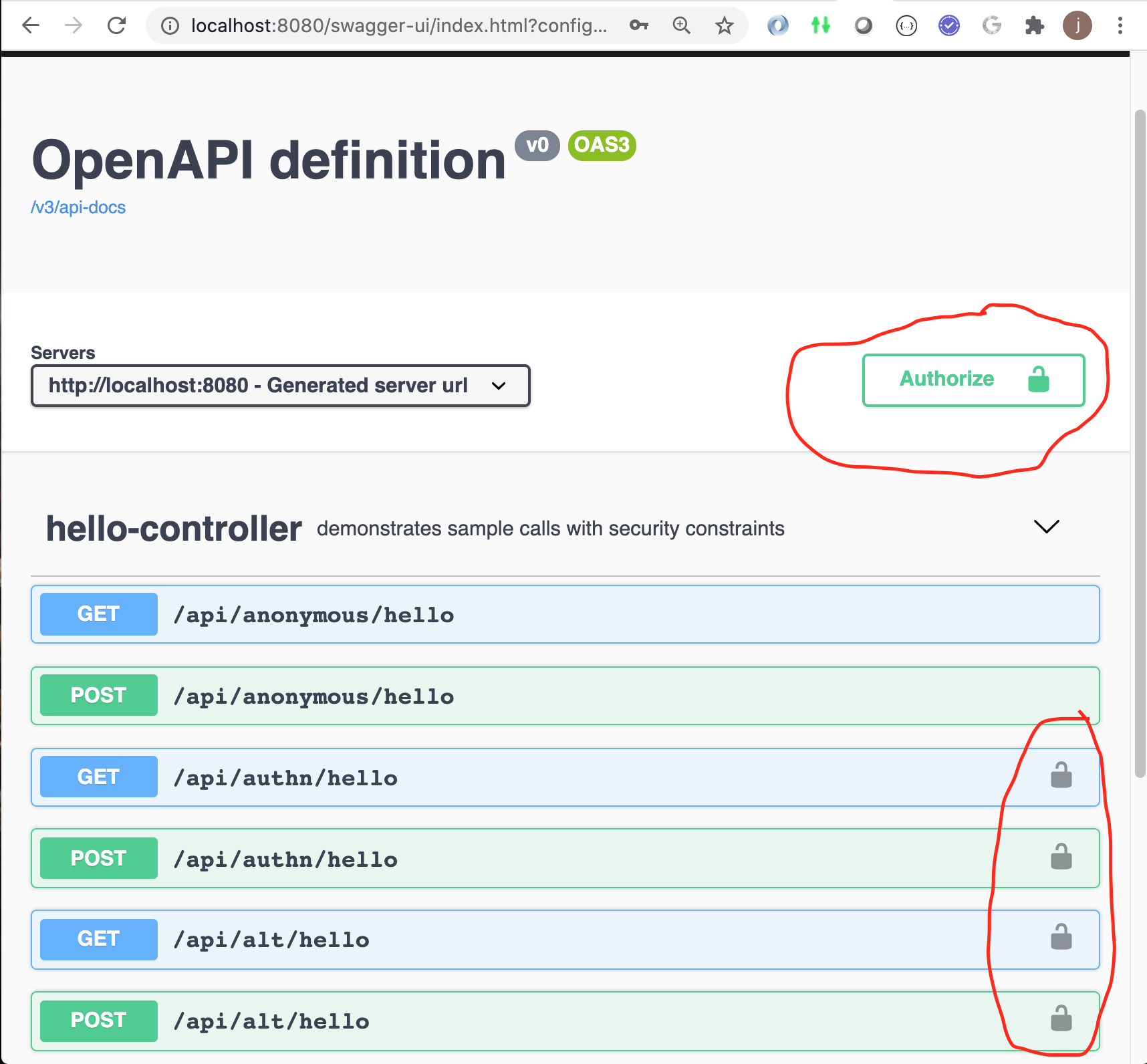
Figure 3. Swagger with BASIC Auth Configured
|
When making a call — Swagger UI adds the Authorization header with the previously entered credentials. |
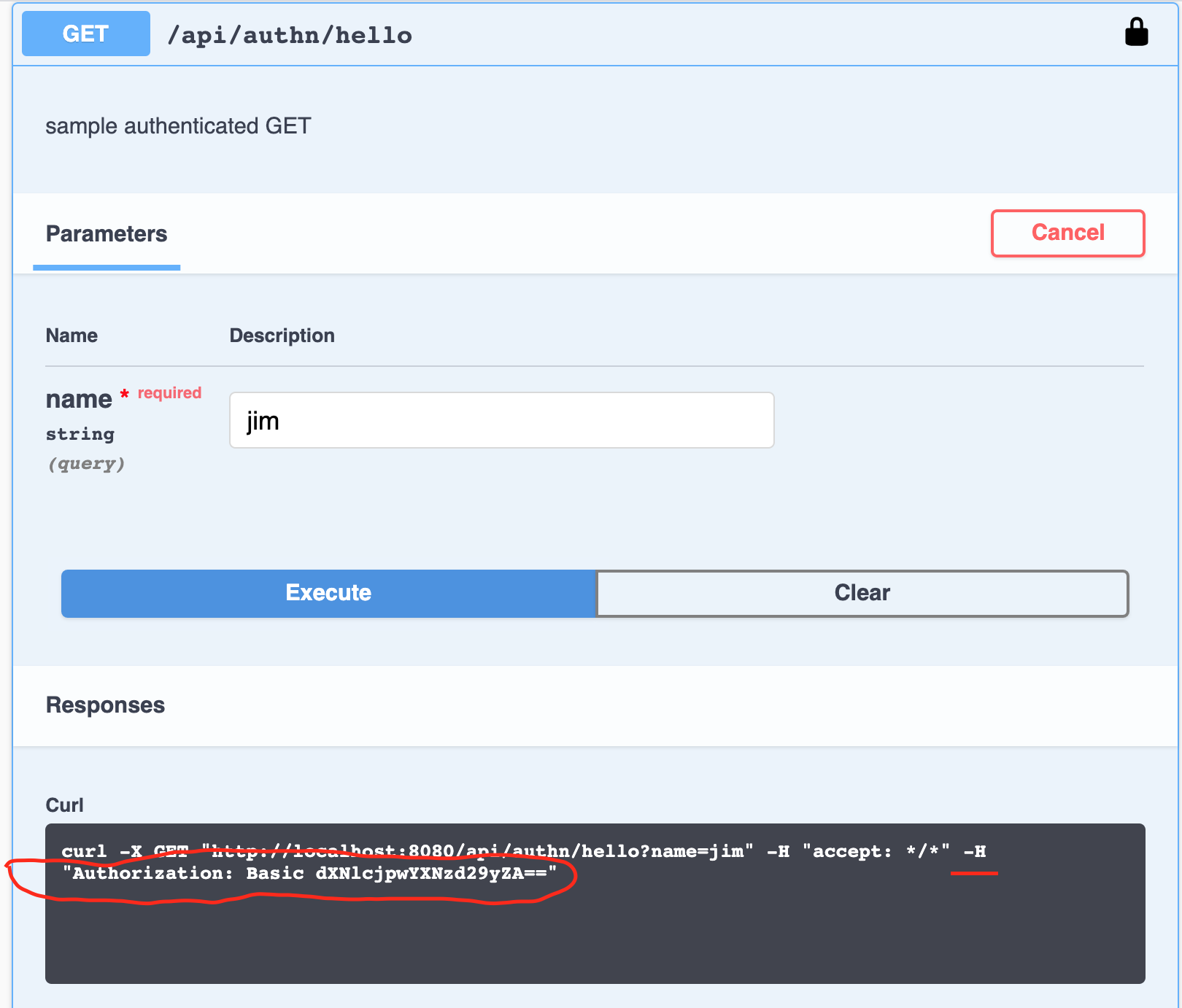
Figure 4. Swagger BASIC Auth Call
|
6. CORS
There is one more important security filter to add to our list before we end, and it is complex enough to deserve its own section - Cross Origin Resource Sharing (CORS).
Using this standard, browsers will supply the URL of the source of Javascript used to call the server — when coming from a different host domain — and look for a response from the server that indicates the source is approved.
Without support for CORS, javascript loaded by browsers will not be able to call the API unless it was loaded from the same base URL as the API.
That even includes local development (i.e., javascript loaded from file system cannot invoke http://localhost:8080).
In today’s modern web environments — it is common to deploy services independent of Javascript-based UI applications or to have the UI applications calling multiple services with different base URLs.
6.1. Default CORS Support
The following example shows the result of the default CORS configuration for Spring Boot/Web MVC.
The server is ignoring the Origin header supplied by the client and does not return any CORS-related authorization for the browser to use the response payload.
$ curl -v http://localhost:8080/api/anonymous/hello?name=jim
> GET /api/anonymous/hello?name=jim HTTP/1.1
> Host: localhost:8080
>
< HTTP/1.1 200
hello, jim :caller=(null)
$ curl -v http://localhost:8080/api/anonymous/hello?name=jim -H "Origin: http://127.0.0.1:8080"
> GET /api/anonymous/hello?name=jim HTTP/1.1
> Host: localhost:8080
> Origin: http://127.0.0.1:8080 (1)
>
< HTTP/1.1 200
hello, jim :caller=(null)| 1 | Origin header normally supplied by browser when coming from a different domain — ignored by server |
The lack of headers does not matter for curl, but the CORS response does get evaluated when executed within a browser.
6.2. Browser and CORS Response
6.2.1. Same Origin/Target Host
The following is an example of Javascript loaded from http://localhost:8080 and calling http://localhost:8080.
No Origin header is passed by the browser because it knows the Javascript was loaded from the same source it is calling.
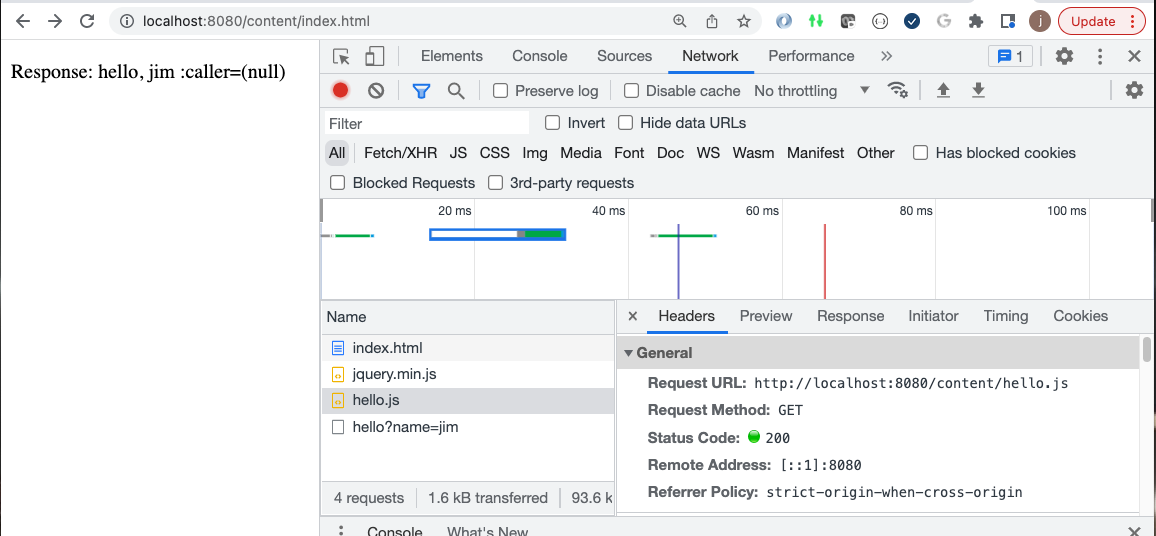
6.2.2. Different Origin/Target Host
However, if we load the Javascript from an alternate source, the browser will fail to process the results.
The following is an example of some Javascript loaded from http://127.0.0.1:8080 and calling http://localhost:8080.
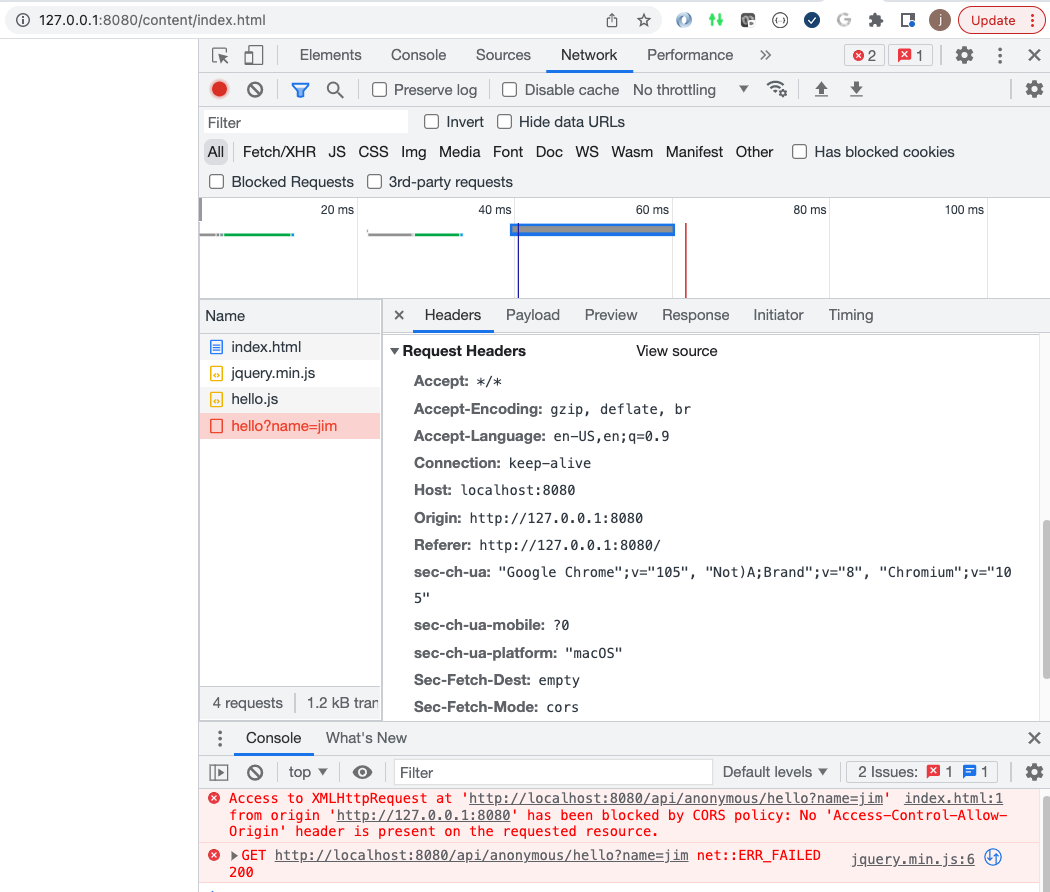
6.3. Enabling CORS
To globally enable CORS support, we can invoke http.cors(…) with a method to call at runtime that will evaluate and return the result for the CORS request — based on a given HttpServletRequest.
This is supplied when configuring the SecurityFilterChain.
http.cors(cfg->cfg.configurationSource(corsPermitAllConfigurationSource()));private CorsConfigurationSource corsPermitAllConfigurationSource() {
return (request) -> {
CorsConfiguration config = new CorsConfiguration();
config.applyPermitDefaultValues();
return config;
};
}package org.springframework.web.cors;
public interface CorsConfigurationSource {
CorsConfiguration getCorsConfiguration(HttpServletRequest request);
}6.3.1. CORS Headers
With CORS enabled and permitting all, we see some new VARY headers (indicating to caches that content will be influenced by these headers).
The browser will be looking for the Access-Control-Allow-Origin header being returned with a value matching the Origin header passed in (* being a wildcard match).
$ curl -v http://localhost:8080/api/anonymous/hello?name=jim
> GET /api/anonymous/hello?name=jim HTTP/1.1
> Host: localhost:8080 (1)
>
* Mark bundle as not supporting multiuse
< HTTP/1.1 200
< Vary: Origin
< Vary: Access-Control-Request-Method
< Vary: Access-Control-Request-Headers (2)
hello, jim :caller=(null)
$ curl -v http://localhost:8080/api/anonymous/hello?name=jim -H "Origin: http://127.0.0.1:8080"
> GET /api/anonymous/hello?name=jim HTTP/1.1
> Host: localhost:8080
> Origin: http://127.0.0.1:8080 (3)
>
< HTTP/1.1 200
< Vary: Origin
< Vary: Access-Control-Request-Method
< Vary: Access-Control-Request-Headers
< Access-Control-Allow-Origin: * (4)
hello, jim :caller=(null)| 1 | Origin header not supplied |
| 2 | No CORS Access-Control-Allow-Origin supplied in response |
| 3 | Origin header supplied by client |
| 4 | Access-Control-Allow-Origin denotes approval for the given Origin (* = wildcard) |
6.3.2. Browser Accepts Access-Control-Allow-Origin Header
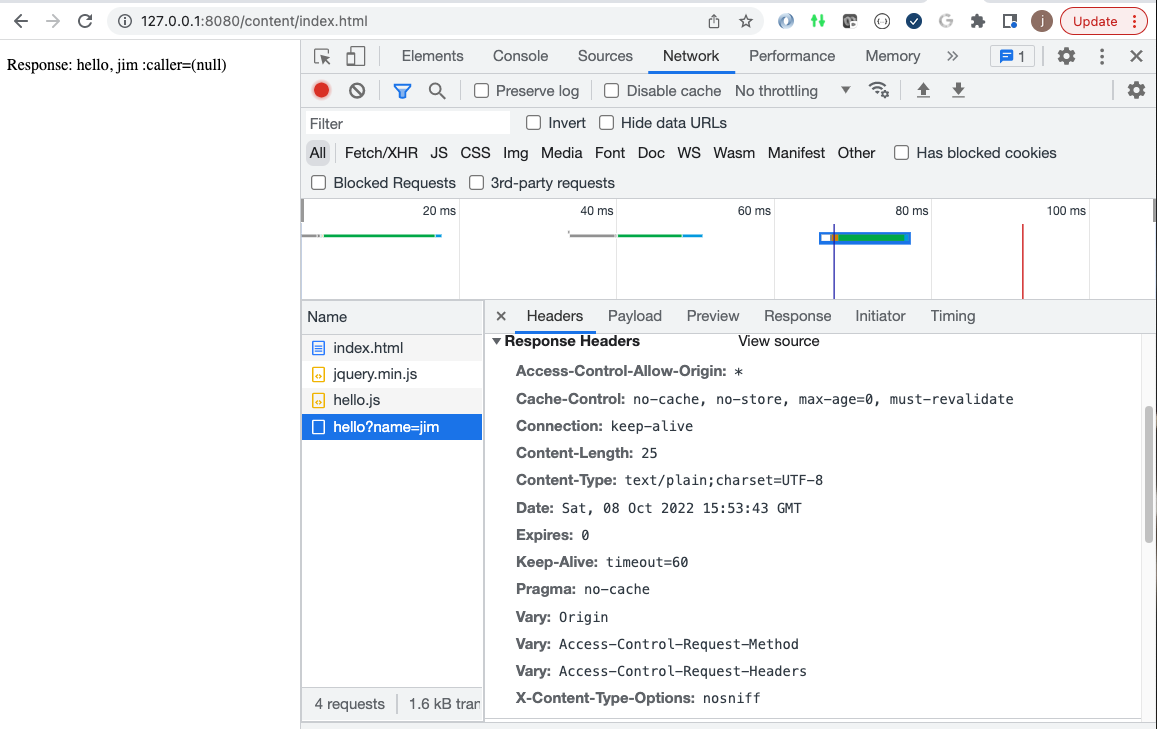
6.4. Constrained CORS
We can define more limited rules for CORS acceptance by using additional commands of the CorsConfiguration object.
private CorsConfigurationSource corsLimitedConfigurationSource() {
return (request) -> {
CorsConfiguration config = new CorsConfiguration();
config.addAllowedOrigin("http://localhost:8080");
config.setAllowedMethods(List.of("GET","POST"));
return config;
};
}6.5. CORS Server Acceptance
In this example, I have loaded the Javascript from http://127.0.0.1:8080 and making a call to http://localhost:8080 in order to match the configured Origin matching rules.
The server is return a 200/OK along with a Access-Control-Allow-Origin value that matches the specific Origin provided.
$ curl -v http://127.0.0.1:8080/api/anonymous/hello?name=jim -H "Origin: http://localhost:8080"
* Trying 127.0.0.1:8080...
* Connected to 127.0.0.1 (127.0.0.1) port 8080 (#0)
> GET /api/anonymous/hello?name=jim HTTP/1.1
> Host: 127.0.0.1:8080 (1)
> Origin: http://localhost:8080 (2)
>
< HTTP/1.1 200
< Vary: Origin
< Vary: Access-Control-Request-Method
< Vary: Access-Control-Request-Headers
< Access-Control-Allow-Origin: http://localhost:8080 (2)
hello, jim :caller=(null)| 1 | Example Host and Origin have been flipped to match approved localhost:8080 Origin |
| 2 | Access-Control-Allow-Origin denotes approval for the given Origin |
6.6. CORS Server Rejection
This additional definition is enough to produce a 403/FORBIDDEN from the server versus a rejection from the browser.
$ curl -v http://localhost:8080/api/anonymous/hello?name=jim -H "Origin: http://127.0.0.1:8080" > GET /api/anonymous/hello?name=jim HTTP/1.1 > Host: localhost:8080 > Origin: http://127.0.0.1:8080 > < HTTP/1.1 403 < Vary: Origin < Vary: Access-Control-Request-Method < Vary: Access-Control-Request-Headers Invalid CORS request
6.7. Spring MVC @CrossOrigin Annotation
Spring also offers an annotation-based way to enable the CORS protocol.
In the example below,
@CrossOrigin annotation has been added to the controller class or individual operations indicating CORS constraints.
This technique is static.
...
import org.springframework.web.bind.annotation.CrossOrigin;
...
@CrossOrigin (1)
@RestController
public class HelloController {| 1 | defaults to all origins, etc. |
7. RestTemplate Authentication
Now that we have locked down our endpoints — requiring authentication — I want to briefly show how we can authenticate with RestTemplate using an existing BASIC Authentication filter.
I am going to delay demonstrating WebClient to limit the dependencies on the current example application — but we will do so in a similar way that does not change the interface to the caller.
7.1. ClientHttpRequestFactory
We will first define a factory for creating client connections. It is quite simple here because we are not addressing things like HTTP/TLS connections. However, creating the bean external from the clients makes the clients connection agnostic.
@Bean
ClientHttpRequestFactory requestFactory() {
return new SimpleClientHttpRequestFactory();
}
This simple ClientRequestFactory will get slightly more complicated when we enable SSL connections.
By instantiating it now in a separate method we will make the rest of the RestTemplate configuration oblivious to the SSL/non-SSL configuration.
|
7.2. Anonymous RestTemplate
The following snippet is an example of a RestTemplate representing an anonymous user. This should look familiar to what we have used prior to security.
@Bean
public RestTemplate anonymousUser(RestTemplateBuilder builder,
ClientHttpRequestFactory requestFactory) {
RestTemplate restTemplate = builder.requestFactory(
//used to read the streams twice -- so we can use the logging filter below
()->new BufferingClientHttpRequestFactory(requestFactory))
.interceptors(new RestTemplateLoggingFilter())
.build(); (1)
return restTemplate;
}| 1 | vanilla RestTemplate with our debug log interceptor |
7.3. Authenticated RestTemplate
The following snippet is an example of a RestTemplate that will authenticate as "user/password" using Http BASIC Authentication. The authentication is added as a filter along with the logger. The business code using this client will be ignorant of the extra authentication details.
@Bean
public RestTemplate authnUser(RestTemplateBuilder builder,
ClientHttpRequestFactory requestFactory) {
RestTemplate restTemplate = builder.requestFactory(
//used to read the streams twice -- so we can use the logging filter below
()->new BufferingClientHttpRequestFactory(requestFactory))
.interceptors(new BasicAuthenticationInterceptor("user", "password"), (1)
new RestTemplateLoggingFilter())
.build();
return restTemplate;
}
| 1 | added BASIC Auth filter to add Authorization Header |
7.4. Authentication Integration Tests with RestTemplate
The following shows the different RestTemplate instances being injected that have different credentials assigned.
The different attribute names, matching the @Bean factory names act as a qualifier to supply the right instance of RestTemplate.
@SpringBootTest(classes= ClientTestConfiguration.class,
webEnvironment = SpringBootTest.WebEnvironment.RANDOM_PORT,
properties = "test=true") (1)
public class AuthnRestTemplateNTest {
@Autowired
private RestTemplate anonymousUser;
@Autowired
private RestTemplate authnUser;| 1 | test property triggers Swagger @Configuration and anything else not suitable during testing to disable |
8. RestClient Authentication
Let’s also show how to authenticate with RestClient.
We can do that using a builder or use a fully configured RestTemplate.
8.1. Anonymous RestClient
The following snippet is an example of a RestClient representing an anonymous user.
@Bean
public RestClient anonymousUserClient(RestClient.Builder builder, ClientHttpRequestFactory requestFactory) { (1)
return builder.requestFactory(//used to read streams twice -- to use logging filter
new BufferingClientHttpRequestFactory(requestFactory))
.requestInterceptor(new RestTemplateLoggingFilter())
.build();
}| 1 | vanilla RestClient with our debug log interceptor |
8.2. Authenticated RestTemplate
The following snippet is an example of a RestClient built from an existing RestTemplate. It will also authenticate as "user/password" using Http BASIC Authentication.
@Bean
public RestClient authnUserClient(RestTemplate authnUser) {
return RestClient.create(authnUser); (1)
}
| 1 | uses already assembled filters from RestTemplate |
9. Mock MVC Authentication
There are many test frameworks within Spring and Spring Boot that I did not cover earlier. I limited them because covering them all early on added limited value with a lot of volume. However, I do want to show you a small example of MockMvc and how it to can be configured for authentication. The following example shows a:
-
normal injection of the mock that will be an anonymous user
-
how to associate a mock to the security context
@SpringBootTest(
properties = "test=true")
@AutoConfigureMockMvc
public class AuthConfigMockMvcNTest {
@Autowired
private WebApplicationContext context;
@Autowired
private MockMvc anonymous; //letting MockMvc do the setup work
private MockMvc userMock; //example manual instantiation (1)
private final String uri = "/api/anonymous/hello";
@BeforeEach
public void init() {
userMock = MockMvcBuilders //the rest of manual instantiation
.webAppContextSetup(context)
.apply(SecurityMockMvcConfigurers.springSecurity())
.build();
}| 1 | there is no functional difference between the injected or manually instantiated MockMvc the way it is performed here |
9.1. MockMvc Anonymous Call
The first test is a baseline example showing a call through the mock to a service that allows all callers and no required authentication. The name of the mock is not important. It is a anonymous client at this point because we have not assigned it any identity.
@Test
public void anonymous_can_call_get() throws Exception {
anonymous.perform(MockMvcRequestBuilders.get(uri).queryParam("name","jim"))
.andDo(print())
.andExpect(status().isOk())
.andExpect(content().string("hello, jim :caller=(null)"));
}9.2. MockMvc Authenticated Call
The next example shows how we can inject an identity into the mock for use during the test method.
We can use an injected or manual mock for this.
The important point to notice is that the mock user’s identity is assigned through an annotation on the @Test.
@WithMockUser("user")
@Test
public void user_can_call_get() throws Exception {
userMock.perform(MockMvcRequestBuilders.get(uri)
.queryParam("name","jim"))
.andDo(print())
.andExpect(status().isOk())
.andExpect(content().string("hello, jim :caller=user"));
}Although I believe RestTemplate tests are pretty good at testing
client access — the WebMvc framework was a very convenient to quickly
verify and identify issues with the SecurityFilterChain definitions.
9.3. MockMvc does not require SpringBootTest
The MockMvc web test framework does not require the full application context implemented by SpringBootTest.
MockMvc provides a means to instantiate small unit tests incorporating mocks behind the controllers.
For example, I have used it as a lightweight way to test ControllerAdvice/ExceptionAdvice.
10. Summary
In this module, we learned:
-
how to configure a
SecurityFilterChain -
how to define no security filters for static resources
-
how to customize the
SecurityFilterChainfor API endpoints -
how to expose endpoints that can be called from anonymous users
-
how to require authenticated users for certain endpoints
-
how to CORS-enable the API
-
how to define BASIC Auth for OpenAPI and for use by Swagger
-
how to add identity to RestTemplate and RestClient clients